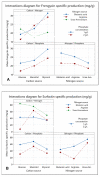Assessment of Lipopeptide Mixtures Produced by Bacillus subtilis as Biocontrol Products against Apple Scab (Venturia inaequalis)
- PMID: 36144412
- PMCID: PMC9501572
- DOI: 10.3390/microorganisms10091810
Assessment of Lipopeptide Mixtures Produced by Bacillus subtilis as Biocontrol Products against Apple Scab (Venturia inaequalis)
Abstract
Apple scab is an important disease conventionally controlled by chemical fungicides, which should be replaced by more environmentally friendly alternatives. One of these alternatives could be the use of lipopeptides produced by Bacillus subtilis. The objective of this work is to study the action of the three families of lipopeptides and different mixtures of them in vitro and in vivo against Venturia inaequalis. Firstly, the antifungal activity of mycosubtilin/surfactin and fengycin/surfactin mixtures was determined in vitro by measuring the median inhibitory concentration. Then, the best lipopeptide mixture ratio was produced using Design of Experiment (DoE) to optimize the composition of the culture medium. Finally, the lipopeptides mixtures efficiency against V. inaequalis was assessed in orchards as well as the evaluation of the persistence of lipopeptides on apple. In vitro tests show that the use of fengycin or mycosubtilin alone is as effective as a mixture, with the 50-50% fengycin/surfactin mixture being the most effective. Optimization of culture medium for the production of fengycin/surfactin mixture shows that the best composition is glycerol coupled with glutamic acid. Finally, lipopeptides showed in vivo antifungal efficiency against V. inaequalis regardless of the mixture used with a 70% reduction in the incidence of scab for both mixtures (fengycin/surfactin or mycosubtilin/surfactin). The reproducibility of the results over the two trial campaigns was significantly better with the mycosubtilin/surfactin mixture. The use of B. subtilis lipopeptides to control this disease is very promising.
Keywords: Bacillus subtilis; Venturia inaequalis; apple scab; biopesticide; fengycin; lipopeptides; mycosubtilin; surfactin.
Conflict of interest statement
F.C. and P.J. from the University of Lille and University of Liège are also the two co-founders of Lipofabrik company, which markets mycosubtilin and other lipopeptides from
Figures








Similar articles
-
Antifungal Activities of Bacillus subtilis Lipopeptides to Two Venturia inaequalis Strains Possessing Different Tebuconazole Sensitivity.Front Microbiol. 2019 Oct 22;10:2327. doi: 10.3389/fmicb.2019.02327. eCollection 2019. Front Microbiol. 2019. PMID: 31695685 Free PMC article.
-
Deciphering the mechanisms involved in reduced sensitivity to azoles and fengycin lipopeptide in Venturia inaequalis.Microbiol Res. 2024 Sep;286:127816. doi: 10.1016/j.micres.2024.127816. Epub 2024 Jun 27. Microbiol Res. 2024. PMID: 38964072
-
Evaluation of Antiradical and Antioxidant Activities of Lipopeptides Produced by Bacillus subtilis Strains.Front Microbiol. 2022 Jun 20;13:914713. doi: 10.3389/fmicb.2022.914713. eCollection 2022. Front Microbiol. 2022. PMID: 35794911 Free PMC article.
-
Lipopeptides from Bacillus: unveiling biotechnological prospects-sources, properties, and diverse applications.Braz J Microbiol. 2024 Mar;55(1):281-295. doi: 10.1007/s42770-023-01228-3. Epub 2024 Jan 13. Braz J Microbiol. 2024. PMID: 38216798 Free PMC article. Review.
-
Key elements and regulation strategies of NRPSs for biosynthesis of lipopeptides by Bacillus.Appl Microbiol Biotechnol. 2020 Oct;104(19):8077-8087. doi: 10.1007/s00253-020-10801-x. Epub 2020 Aug 19. Appl Microbiol Biotechnol. 2020. PMID: 32813066 Review.
Cited by
-
Broad-Spectrum Antifungal, Biosurfactants and Bioemulsifier Activity of Bacillus subtilis subsp. spizizenii-A Potential Biocontrol and Bioremediation Agent in Agriculture.Plants (Basel). 2023 Mar 20;12(6):1374. doi: 10.3390/plants12061374. Plants (Basel). 2023. PMID: 36987062 Free PMC article.
-
Improving Surfactin Production in Bacillus subtilis 168 by Metabolic Engineering.Microorganisms. 2024 May 15;12(5):998. doi: 10.3390/microorganisms12050998. Microorganisms. 2024. PMID: 38792827 Free PMC article.
-
Additive Effect of the Composition of Endophytic Bacteria Bacillus subtilis on Systemic Resistance of Wheat against Greenbug Aphid Schizaphis graminum Due to Lipopeptides.Life (Basel). 2023 Jan 11;13(1):214. doi: 10.3390/life13010214. Life (Basel). 2023. PMID: 36676163 Free PMC article.
-
The Effect of Cultivation Conditions on Antifungal and Maize Seed Germination Activity of Bacillus-Based Biocontrol Agent.Bioengineering (Basel). 2022 Dec 13;9(12):797. doi: 10.3390/bioengineering9120797. Bioengineering (Basel). 2022. PMID: 36551004 Free PMC article.
-
The structure of lipopeptides impacts their antiviral activity and mode of action against SARS-CoV-2 in vitro.Appl Environ Microbiol. 2024 Nov 20;90(11):e0103624. doi: 10.1128/aem.01036-24. Epub 2024 Oct 24. Appl Environ Microbiol. 2024. PMID: 39445780 Free PMC article.
References
-
- MacHardy W.E. Apple Scab: Biology, Epidemiology, and Management. APS Press; St. Paul, MN, USA: 1996.
-
- Chatzidimopoulos M., Lioliopoulou F., Sotiropoulos T., Vellios E. Efficient Control of Apple Scab with Targeted Spray Applications. Agronomy. 2020;10:217. doi: 10.3390/agronomy10020217. - DOI
Grants and funding
LinkOut - more resources
Full Text Sources

